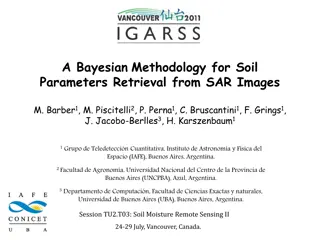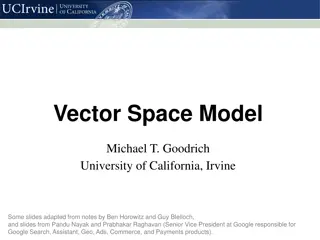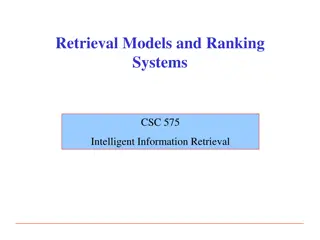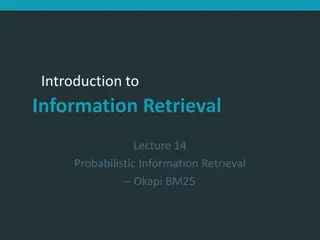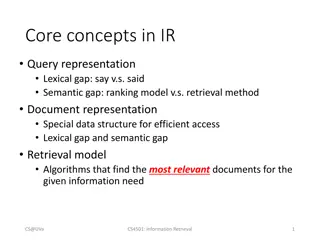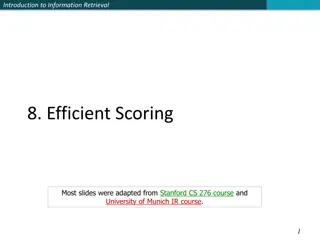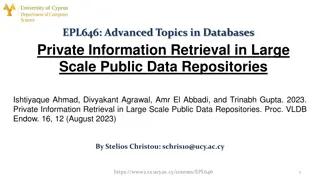Efficient Solutions for Large-Scale Text Document Retrieval
In the realm of large-scale search and machine learning, implementing efficient solutions for text document retrieval is crucial. Techniques like inverted index and bitwise operations help overcome challenges of storage and sparsity in managing vast collections of documents. Measures like precision and recall play a key role in evaluating the effectiveness of retrieval systems, highlighting the tradeoff between relevance and comprehensiveness. By leveraging these methods, the classical search problem of retrieving relevant documents from a massive text collection can be addressed effectively.
Download Presentation

Please find below an Image/Link to download the presentation.
The content on the website is provided AS IS for your information and personal use only. It may not be sold, licensed, or shared on other websites without obtaining consent from the author. Download presentation by click this link. If you encounter any issues during the download, it is possible that the publisher has removed the file from their server.
E N D
Presentation Transcript
Large Scale Search: Inverted Index, etc. Comp: 441/552 Large Scale Machine Learning
Classical Search Problem Given: A (giant) set of text documents Assume it is a static collection for the moment Task: Retrieve documents that is relevant to the user s query
The Measures: Precision and Recall Precision : Fraction of retrieved docs that are relevant to the user s information need ???????? ???? ????????? ???? ????????? ???? ????????? = Recall : Fraction of relevant docs in collection that are retrieved ???????? ???? ????????? ???? ???????? ???? ?????? = There is usually a tradeoff between these two. For example if we report everything, recall is 1. ????????? ?????? ?????????+?????? ?1????? = 2
Example Search for Documents containing the words Brutus AND Caesar but NOT Calpurnia Na ve Solution: grep Brutus and Caesar, then strip out lines containing Calpurnia Problem: Won t work for the web. Just too slow!
Sec. 1.1 Term-document Matrix Doc1 Doc2 Doc3 Doc4 Doc5 Doc6 1 1 0 0 0 1 Antony 1 1 0 1 0 0 Brutus 1 1 0 1 1 1 Caesar 0 1 0 0 0 0 Calpurnia 1 0 0 0 0 0 Cleopatra 1 0 1 1 1 1 mercy 1 0 1 1 1 0 worser 1 if Document contains word, 0 otherwise Picture Taken from Internet
An Efficient Solution 0/1 can be treated as bit-vector. To answer query: take the vectors for Brutus, Caesar and Calpurnia (complemented) BITWISE AND 110111 AND 110100 AND 101111 = 100100 Doc1 Doc2 Doc3 Doc4 Doc5 Doc6 1 1 0 0 0 1 Antony 1 1 0 1 0 0 Brutus 1 1 0 1 1 1 Caesar 0 1 0 0 0 0 Calpurnia 1 0 0 0 0 0 Cleopatra 1 0 1 1 1 1 mercy 1 0 1 1 1 0 worser Picture Taken from Internet
Issue: Cant build the Matrix Even for 1 million documents, with say 500K distinct terms. We get around half a trillion 0s and 1s. Storage will blow up. Every document is sparse and usually contains around 1000 terms on average, so the number of 1s is around a billion. How to exploit sparsity ?
Sec. 1.2 Solutions: Inverted index or Postings We need variable-size postings lists On disk, a continuous run of postings is normal and best Generally a linked list (good for insertion). Sorted (Why?) 1 2 4 11 31 45173 174 Brutus 1 2 4 5 6 16 57 132 Caesar 2 31 54101 Calpurnia Dictionary Picture Taken from Internet 8
Manipulating Sorted list is linear time. Picture Taken from Internet
Some Benefits All Boolean Operation is O(x+y). BITWISE AND is now Intersection of Postings. OR is MERGE Set DIFF can also be done similarly. Primary commercial retrieval tool for 3 decades. Order of operation is important. X AND Y AND Z. X AND Y first or Y AND Z first ? A whole Topic in itself: Query Optimization
Sec. 1.2 Indexer steps: Token sequence Sequence of (Modified token, Document ID) pairs. Doc 1 Doc 2 I did enact Julius Caesar I was killed i the Capitol; Brutus killed me. So let it be with Caesar. The noble Brutus hath told you Caesar was ambitious Picture Taken from Internet
Sec. 1.2 Indexer steps: Sort Sort by terms And then docID Picture Taken from Internet
Sec. 1.2 Indexer steps: Dictionary & Postings Multiple term entries in a single document are merged. Split into Dictionary and Postings Doc. frequency information is added for query optimization. Storage ? Picture Taken from Internet
Phrase Queries ? How about queries like Rice University Solution 1: Use Bi-grams. 2-contiguous words as tokens. This is Rice University gets 3 tokens This is , is Rice , and Rice University Problems: Longer phrases will blow up the dimentionality. If the vocabulary is 500k, then bi-grams are (500k)*(500k). Trigrams etc. ? Picture Taken from Internet
Sec. 2.4.2 Another Popular Solution: Positional Index <Rice: 993427; 1: 7, 18, 33, 72, 86, 231; 2: 3, 149; 4: 17, 191, 291, 430, 434; 5: 363, 367, > Which of docs 1,2,4,5 could contain Rice University ? For phrase queries, we use a merge algorithm recursively Can now do all sorts of phrase queries, slower than bi-grams but more expressive. (An ideal solution is usually a combination) Still needs significant memory. (2-4x more for positions) Picture Taken from Internet
Sec. 2.4.2 Processing a phrase query Extract inverted index entries for each distinct term: Rice, University. Merge their doc:positionlists to enumerate all positions with Rice University . Rice: 2:1,17,74,222,551; 4:8,16,190,429,433; 7:13,23,191; ... University: 1:17,19; 4:17,191,291,430,434; 5:14,19,101; ... Same general method for proximity searches
Power Law in Real World Catching results is a very powerful idea. Identifying Heavy-Hitters on data streams is a topic in itself. Picture from https://moz.com/blog/illustrating-the-long-tail









